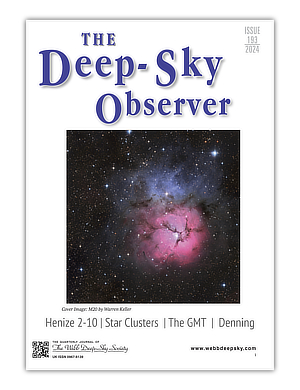Deep-Sky Observer - DSO 193

In this issue
Celestia Obscura: Henize 2-10 by Scott N. Harrington
Where there’s smoke, there’s star clusters by Mark Bratton
The Rise and Fall of the Great Melbourne Telescope by Steve Gottlieb
William Frederick Denning and the nebulae by Owen Brazell
Object of the Season: Planetary Nebula M57 in Lyra by Wolfgang Steinicke
Editorial
As I write this editorial we have probably had the worst Winter/Spring observing season I can remember. It has been a continual run of storms along with clouds and rain here in the UK. We have also had extensive flooding. The moisture in the air has also meant that on the odd clear nights we have had the transparency has been terrible. I guess we can attribute this to global warming as a warmer Atlantic means more and stronger storms and the warmer air holds more moisture. The jet stream also appears to have moved south so the storms that would have normally passed over Scotland and the Icelandic gap are now coming over the southern UK.
Perhaps surprisingly given this the Society is still growing and we have an excellent mix of articles in this issue of DSO. The Society is also holding its Annual Meeting/AGM on the 15th June at the IOA in Cambridge England. I am sorry that we will not be able to stream the meeting and this is something that we still need to look further into. The Society had a very successful day at the Practical Astronomy Show in March. This will probably be the only main show we will go to this year as the costs are now too much for a stand at the other main UK trade shows. It seems that, perhaps unsurprisingly, the 2024 BAA deep sky section meeting was focused mainly on imaging which is I guess the way the world is going.
In terms of Webb Publications, we are working on a Galaxy of the Month (GOM) Vol. 2 book which should be out, probably end of this year or early next and hopefully at some point there will be a Double Star of the Month book but that is likely to be 2025/26 at the earliest. We are also hoping to have DSSC 32 out in the summer.
In terms of new items related to deep sky astronomy, the much anticipated publication of the second edition of the Atlas of Messier Objects from CUP has finally arrived and the Society should have some to sell. There is also due out a book from CUP called The Cambridge Compendium on John Herschel, slated for May 2024 but I would not be surprised if this slips by a long way as well. As always if people know of other books from publishers I don’t check often then let me know and I can pass this on to the community. The Springer Patrick Moore series appears to be running out of steam and there have been very few books published on the deep sky there either. However, Alvin Huey is back and has updated a couple of his guides at Faint Fuzzies.
In terms of software the hoped for release of AstroPlanner 2.4 mentioned in the last DSO still has not happened. It seems the author is getting bogged down with increasingly odd requests to modify the program for imagers. SkyTools Visual 4.1, which as previously mentioned will mostly be for EAA, does not have a release date but one assumes mid H2 2024. I must admit I find it hard to understand how EAA is classed as visual astronomy as you just sit at a computer and look at images coming in from a camera. To my mind it is really just cheap imaging. Otherwise as mentioned in many previous editorials the main thrust of software development seems to be towards the imagers. I note that the Carte du Ciel project still has regular updates but whether it ever gets out of 4.3 beta I don’t know.
In hardware terms the main change has been the adoption of Smart scopes. First popularised by the French companies Unistellar and Vaonis the Chinese have now entered the game with a couple of small aperture (50mm or less) telescopes from DwarfLab and ZWO. These have been very popular as introductory scopes, although it appears that many users don’t see them as that and keep wanting full blown imaging capability with them. They really do seem to be just plonk and go and are controlled from a smartphone or tablet. The prices of these at around £550 is less than a TeleVue Ethos eyepiece nowadays! These telescopes are classified I believe as EAA scopes and are AltAz mounted so will have limited exposure times due to field rotation. There are always compromises with cost so it will be interesting to see how these hold up in terms of reliability over the next couple of years. Their size/ resolution will also determine the kind of targets they can be used on. Celestron have also entered this market with their Origin telescope which is a 6” RASA aimed at the type of people, although vastly more expensive at around £4000, although I have not yet seen any images taken with this so I am not sure if it is actually out.
Owen Brazell - Editor of The Deep-Sky Observer